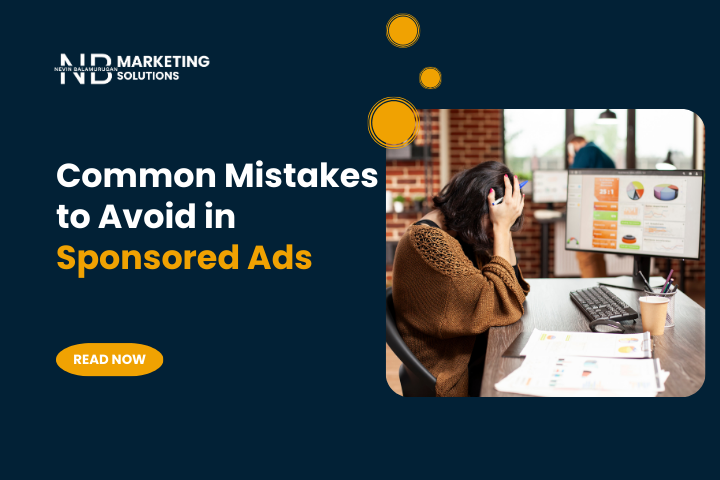Sponsored Ads: Common Mistakes You Need to Avoid in 2025
Abirami Dharmalingam
September 20, 2025

Why Sponsored Ads aren’t Working? How to Fix Them?
You launched your sponsored ads with high hopes, only to see High traffic, but Low click-through rate, and No conversions.
Most paid ads fail not because the platform doesn’t work, but because of small, unavoidable mistakes that quietly cut down your campaign performance. Many paid campaigns underperform due to these common mistakes in sponsored content.
But these mistakes can be fixed. Maybe your targeting is off, your ad copy isn’t compelling, or your landing page isn’t ready to convert. With a few adjustments, you can see better results in your ongoing campaign.
Can’t wait to see it? In this blog, we’ll walk you through the common mistakes you need to avoid in sponsored ads, and more importantly, we will also help you fix them.

What are Sponsored Ads?
Sponsored ads are paid advertisements where you pay a fee each time a customer clicks your ad. You can use this type of advertising to promote your brand, sell your product, or service.
This operates on a pay-per-click (PPC) model, where you bid on specific keywords related to your business, allowing your ads to appear in search engines like Google and Bing, as well as social media platforms such as Facebook, Instagram, LinkedIn, and Pinterest.
Why Should You Use Sponsored Ads for Your Business?
Well, you have several reasons to use sponsored ads for your business, mainly to increase brand awareness, drive high traffic, and boost conversions.
Here, we’ve included the main benefits of why your competitors use sponsored ads for their marketing.
- Reach new customers: Sponsored ads allow you to get in front of your potential customers who aren’t aware of your business.
- Measurable results: You can measure metrics like click-through rates, impressions, and conversion rates.
- Increase your sales: By doing this, customers can increase their order value and order volume (the number of times they buy), which leads to generating high revenue.
- Cost-effective: You can control your budgets, with the ability to set maximum bid amounts and to daily adjust your spending limits. More importantly, you don’t need to give money beforehand – you pay only for clicks.
- Build brand loyalty: If your customers love your product or service, it leads to trust. This tends to speak about your business listings with their family or friends to increase visibility and brand loyalty.
- Increase conversion rate: You connect directly with customers who are interested in your product or service, which leads to conversion.
- Improve return on investment (ROI): With these ads, you only pay when a customer clicks on the ad, you do not need to pay when they just view it without taking a specific action.
Common Mistakes You Need to Avoid in Sponsored Ads
Let’s break down the most common mistakes you’re making in your sponsored ads, and we’ll let you know how to fix them.
- You’re not targeting your audience
- You’re setting unclear objectives
- Your content doesn’t capture attention
- You’re not choosing the right ad formats
- You’re using a complicated landing page
#1 Mistake: You’re Not Targeting Your Audience
If your sponsored ads aren’t performing, chances are you’re speaking to the wrong people. No matter how good your message or ad copy is, it won’t convert others if they’re not your target audience.
You can have great visuals, a strong offer, and a polished landing page. But if your wrong audience has no interest or need for what you’re offering, your ad spend will disappear within a few minutes. You need to conduct market research by:
What is my target audience’s age?
What are the pain points or challenges they face?
Where do they live?
What platforms do they use?
What types of ad formats do they commonly see?
There are multiple options for conducting market research. If you need more ideas to identify your target audience, read: How to Find a Target Audience
Here’s how to fix it:
- Go where your audience is: Find out where your audience actually hangs out and make sure it’s the right place to make your brand visible.
- Match the platform to your audience: Each platform attracts a different type of customer. For example, TikTok and Instagram are best for younger audiences, while LinkedIn is better for professionals and B2B. So, pick the platform where your audience is already active.
- Audience insights: Use analytics and customer insights to understand who is actually clicking, engaging, and converting with your ad.
- Choose a specific audience: Don’t go for a broad audience; go for a specific target audience. With age and location, you can also include your customer details, such as interests, job roles, customer behaviors, etc.
#2 Mistake: You’re Setting Unclear Objectives
Knowing who you want to reach is not only one of the common mistakes in sponsored ads. You need to know what you want out of your ad campaign.
Ask yourself, what is the goal of your ad?
Whether it can be,
- Brand awareness
- Product or service awareness
- Conversions
With a clear objective, you can tailor your ad content and target your specific audience to achieve these goals. Without an objective, you cannot generate revenue.
#3 Mistake: Your Content Doesn’t Capture Attention
Even the best platform won’t save your ad if your content fails to grab attention. Today, boring ads get ignored, so ask yourself when creating content for your ad:
Will they stop scrolling to read or watch this?
Is the headline clear, compelling, and benefit-driven?
Can every customer understand the offer within the overview of the content?
Will they take the next step to read about the feature?
If any one of your questions gets the answer “no”, your content is weak; make them strong with:
- Use User-Generated Content (UGC): Your ads can include authentic reviews, testimonials, or real customer videos because customers trust other peers more than brands.
- Test multiple creatives: Some audiences respond to emotional storytelling, others to benefit-focused messaging, or even data-driven proof. So, experiment with variations to see what resonates most.
- Highlight unique selling proposition (USP): Make sure the audience immediately sees why your product or offer is different and better than your competitors.
- Optimize ads for each platform: Each social channel has unique features. Instagram, TikTok, and YouTube Shorts love engaging video clips, and LinkedIn loves professional and informative content.
- Use compelling headlines and copy: Use attention-grabbing headlines that communicate benefits that can improve ad performance. And make the first few words irresistible.
#4 Mistake: You’re Not Choosing the Right Ad Formats
You need to choose the most effective ad format for sponsored ads to deliver your message. Each ad format has different strengths and weaknesses.
Let’s break down some of the most popular ad formats.
- Paid search: These text-based search ads appear with a “sponsored” note at the top of the search engine result pages (SERPs). It occurs when a customer searches for certain keywords based on a niche.
- Social media ads: Text, images, videos, and carousels with sponsored notes are available on platforms like Facebook, Instagram, YouTube, LinkedIn, Pinterest, and X (formerly Twitter).
- Display ads: These visual ads usually serve as banner ads or pop-up ads that appear on websites and apps.
- Video ads: Videos are a popular ad format that conveys a lot of information quickly. It can be long or short, but it serves based on specific social media platforms or websites.
- Audio ads: They typically appear for 15-30 seconds and are mostly music-driven with voice-overs. It mainly appears on platforms like Apple Music, Spotify, etc.
- Influencer marketing: Influencers discuss your product or service to convince your audience to buy.
#5 Mistake: You’re Using a Complicated Landing Page
No matter how compelling your ad is, a poor PPC landing page can drain your campaign performance.
Here are the most common landing page mistakes and how to fix them:
- Slow loading: Customers expect instant results. If your landing page takes longer than 3 – 5 seconds to load, visitors will bounce. So, optimize images, reduce unnecessary things, and use fast hosting to improve load times.
- Multiple competing goals: Too many calls to action or messaging can confuse customers. Focus on one clear, benefit-driven goal to guide customers toward conversion.
- Mobile-friendly design: With the majority of traffic coming from mobile devices, your landing page must be mobile-friendly. Ensure buttons are easy to tap, forms are simple, and content adapts to different screen sizes.
- Complex forms: Forms need to be short and include only a few fields that you need, don’t add too many fields to make your customers bounce your landing page. Ask only for essential information to reduce friction and increase completion rates.
- Lack of social proof: Include authentic reviews, testimonials, security badges, or case studies to build credibility.
Don’t Use These Common Mistakes in Your Paid Ads
Sponsored ads can help your business grow, but you need to avoid these common mistakes to generate revenue. Even if you have made a mistake, you can easily fix it. If you find that your sponsored ads aren’t working after making these adjustments, you can contact NB Marketing. Our experts analyze your campaigns’ ins and outs and optimize to help your business grow.
Recent Posts
Have Any Question?
- (+91) 938-542-1049
- info@nbmarketingsolutions.in
Categories
Make Appointment
Confused Over Choosing The Right Services For Your Business?
Tamil Nadu, India
- Near TMB Bank, Anjugramam post, Kanyakumari 629401
- info@nbmarketingsolutions.in
- (+91)93-8542-1049
